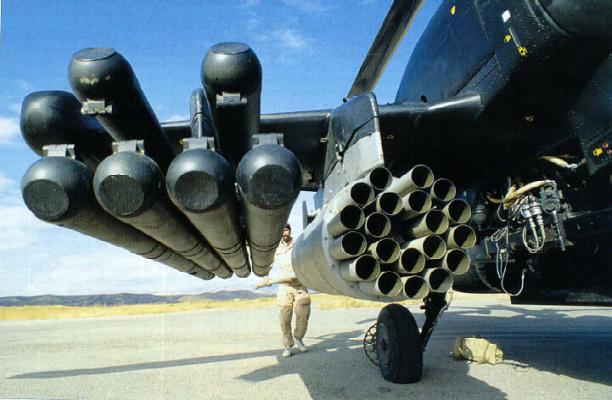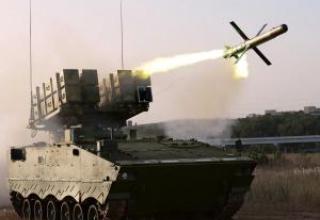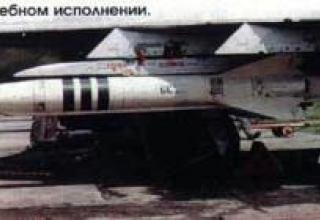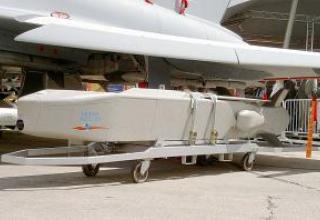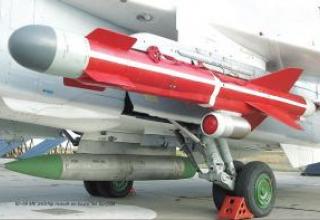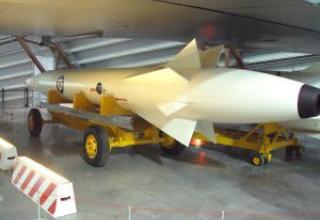The "Vortex" aircraft anti-tank missile system is designed to engage armored vehicles, including those equipped with reactive armor, and low-speed air targets, flying at speeds up to 800 km / h.
The development of the complex was started in 1980 in the Instrumentation Design Bureau (NPO "Tochnost") under the supervision of Chief Designer A.G. Shipunov. It was adopted for service in 1992.
By early 2000, the complex was used on the anti-tank attack aircraft Su-25T (Su-25TM, Su-39, hanged up to 16 missiles on two ACU-8 launchers) and combat helicopter Ka-50 "Black Shark". (hangs up to 12 missiles on two PU).
In 1992, the exhibition in Farnborough was first shown an improved version of the rocket "Vortex-M".
There is a version of the ship complex "Vikhr-K", which includes 30 mm artillery AK-306 and four PTUR "Vikhr" with a range of 10 km. The "Vikhr" complex is to be equipped with patrol ships and boats.
In the west, the "Vikhr" system was designated AT-12 (AT-9).
Composition:
The Vortex Missile Weapon System is a part of it:
- supersonic laser guided missile 9A4172 (see diagram);
- round-the-clock sightseeing system I-251 "Squall";
- airborne ACU-8 or ACU-6 launcher;
The complex allows firing single missiles and a volley of two missiles. The missile's high supersonic speed (up to 610 m/sec) reduces the helicopter's vulnerability during an attack and allows it to engage multiple targets in one go. The distance of 4 km the missile flies for 9 seconds. For comparison: the most powerful U.S. anti-tank helicopter missile FGN-114K "Hallfire" has subsonic speed and covers this distance for 15 seconds.
The rocket is made by the aerodynamic scheme "duck" with a folding wing. It is guided by an all-day automatic sighting system. When approaching the target area, the coordinates of which are pre-installed in the BCVM helicopter, at a distance of about 12 km automatically turns on the mode of television scanning of the terrain. Once the target is detected on the television screen, the pilot directs the helicopter towards the target, then frames the target with a reticle and presses the automatic tracking button. The sight switches to automatic tracking of the target, and when the permitted range is reached, it launches the missile.
Type of launch - from the transport and launch container with an embossing charge.
The laser-beam guidance system in combination with the automatic target tracking system guarantees high accuracy of firing, almost independent of the range. The power of laser-beam control system radiation, an order of magnitude lower than the threshold power of foreign warning systems of laser irradiation, provides high secrecy of application. The probability of destruction of a small mobile target of the "tank" class by the "Vortex" missile is 80%.
Storage, transportation and application of the missile is carried out with the use of a transport and launch container, which ensures unregulated storage of PTSD for 10 years.
The 9A4172 CBM with a leading cumulated charge is capable of penetrating the armour (including active) of the most advanced foreign tanks from any angle. Maximum armor penetration is 1000 mm. The "Vortex" has contact and non-contact fuses.
Characteristics:
| Developer | Instrument Engineering Design Bureau |
| Range of fire, km: - afternoon - at night |
0.5-10 up to 5 (6) |
| Launch height, m | 5-4000 |
| Time of flight, s: - at maximum range - at a range of 8000m - at a range of 6000m |
28 23 14 |
| Average flight speed, m/s | 600 |
| The dimensions of missile 9A4172, mm: - length - maximum housing diameter - wingspan - range of stabilizers |
2750 125-130 240 380 |
| Launch weight of the rocket, kg | 40-45 |
| The dimensions of the TIC, mm: - length - diameter |
2870 140 |
| Missile weight in TPK, kg | 59 |
| Application temperature, deg oC | between -50 and +50 |
| Fighting unit: - weight, kg - explosive weight, kg - fuse type - non-contact fuse range, m |
8-12 4-5.5 contact and non-contact 2.5-3.0 |
| Control equipment I-251 "Squall" | |
| - day channel | television |
| - night channel | thermal imaging |
| - target tracking system | automatic |
| Aircraft Launch Unit CCP-8 | |
| Carrier | Su-25T (Su-39) |
| Number of rockets per PU | 8 |
| Weight of empty/charged PU, kg | 60/535 |
| Length PU, mm | 1524 |
| PU width, mm | 720 |
| Height PU, mm | 436 |
| Pointing angle in vertical plane, deg | 10 |
| Aviation launcher CCP-6 | |
| Carrier | Ка-50 (Ка-52) |
| Number of rockets per PU | 6 |
| Weight of empty PU, kg | 60 |
| Length PU, mm | 1524 |
| PU width, mm | 720 |
| Height PU, mm | 436 |
| Pointing angle in vertical plane, deg | 10 |
Testing:
According to data dated July 2018, the Soviet side sold the rockets and other components of the Hurricane system (it is worth understanding the Hurricane MLRS) to the Syrian side. Some of these rockets were handed over to the Hezbollah movement in the early 2000s.
In 2002, Alyazhedinov Vadim Rashitovich, Skirda Viktor Andreevich was awarded the S.I. Mosin Prize for his work on the topic: "The Hurricane multiple launch rocket system with increased accuracy and heap of fire.
Sergei Sivtsov - designer of control system elements. He made a significant contribution to the development of correcting switchgears for the angular stabilization systems of Smerch and Uragan Rocket Launcher Systems. He took direct part in working out of the given elements, tests and their introduction in a batch production.
Sources:
- А.В.Карпенко, С.М. Ганин "Отечественные авиационные тактические ракеты", "Бастион" N1, 2000г.
- В.Ильин. "Вестник Авиации и Космонавтики", 8-9, 1997.
